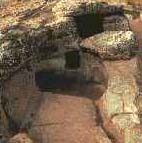 In the first of a series of articles that the Lebanaon newspaper, The Daily Star, will publish on an ongoing basis with the cooperation of the American Schools of Oriental Research, the leading North American scholarly body for the study of the ancient Middle East, Professor Larry G. Herr of Canadian University College describes ancient burials found in one of the few preserved dolmens in Jordan.
In the first of a series of articles that the Lebanaon newspaper, The Daily Star, will publish on an ongoing basis with the cooperation of the American Schools of Oriental Research, the leading North American scholarly body for the study of the ancient Middle East, Professor Larry G. Herr of Canadian University College describes ancient burials found in one of the few preserved dolmens in Jordan.
"Dolmens can be found throughout the Mediterranean and Europe, dispersed between sites ranging from Wales to Tunisia. Until recently, thousands existed in concentrated groupings in Jordan. Constructed with large boulders, the dolmens often exceeded 3 meters in size. Sadly, modern construction activity in towns and villages has destroyed many of the dolmen fields, leaving few behind."
"There are several types of dolmens, all of them bearing similar features. The most common type found in the Middle East are composed of two large rectangular blocks standing upright and parallel to each other, about a meter apart. Smaller stones were placed at the end, with a large stone capping the construction. The ends of the capstone often overlapped the edges of the walls. Archaeologists rarely find more than the two parallel side stones and the capstone, sometimes collapsed."
"Because the ancients built dolmens above ground, forces of nature have largely swept away their contents, leaving archaeologists to debate when and how they were used. The most widely accepted theory is that they were used as tombs, but others have suggested that were employed as stables for small flocks or storage caches."
"Thanks to the Umayri discovery, archaeologists have been able to suggest that the structures were indeed used for burials and that they date to the late fourth millennium BC."
No comments:
Post a Comment